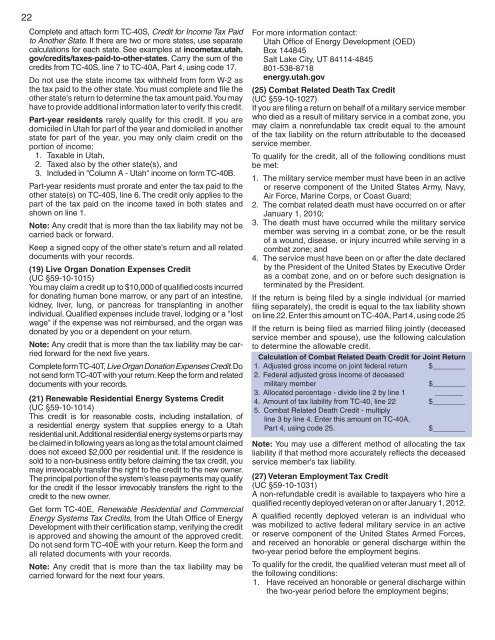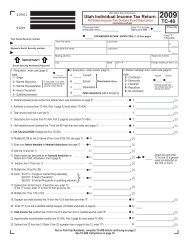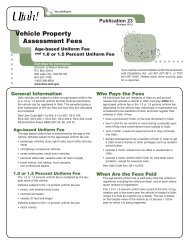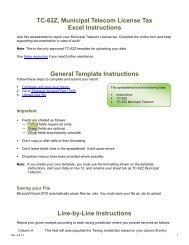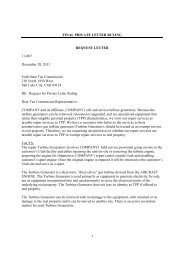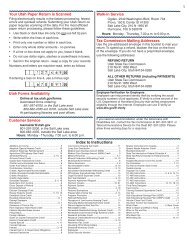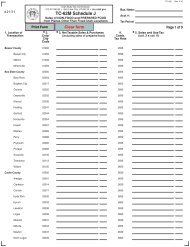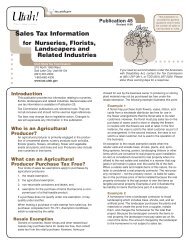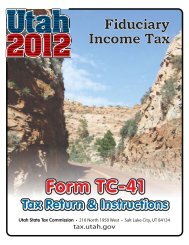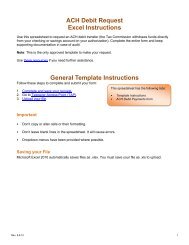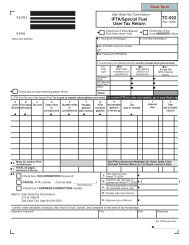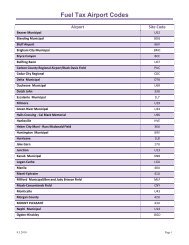TC-40 Instructions - Utah State Tax Commission - Utah.gov
TC-40 Instructions - Utah State Tax Commission - Utah.gov
TC-40 Instructions - Utah State Tax Commission - Utah.gov
Create successful ePaper yourself
Turn your PDF publications into a flip-book with our unique Google optimized e-Paper software.
22<br />
Complete and attach form <strong>TC</strong>-<strong>40</strong>S, Credit for Income <strong>Tax</strong> Paid<br />
to Another <strong>State</strong>. If there are two or more states, use separate<br />
calculations for each state. See examples at incometax.utah.<br />
<strong>gov</strong>/credits/taxes-paid-to-other-states. Carry the sum of the<br />
credits from <strong>TC</strong>-<strong>40</strong>S, line 7 to <strong>TC</strong>-<strong>40</strong>A, Part 4, using code 17.<br />
Do not use the state income tax withheld from form W-2 as<br />
the tax paid to the other state. You must complete and fi le the<br />
other state's return to determine the tax amount paid. You may<br />
have to provide additional information later to verify this credit.<br />
Part-year residents rarely qualify for this credit. If you are<br />
domiciled in <strong>Utah</strong> for part of the year and domiciled in another<br />
state for part of the year, you may only claim credit on the<br />
portion of income:<br />
1. <strong>Tax</strong>able in <strong>Utah</strong>,<br />
2. <strong>Tax</strong>ed also by the other state(s), and<br />
3. Included in "Column A - <strong>Utah</strong>" income on form <strong>TC</strong>-<strong>40</strong>B.<br />
Part-year residents must prorate and enter the tax paid to the<br />
other state(s) on <strong>TC</strong>-<strong>40</strong>S, line 6. The credit only applies to the<br />
part of the tax paid on the income taxed in both states and<br />
shown on line 1.<br />
Note: Any credit that is more than the tax liability may not be<br />
carried back or forward.<br />
Keep a signed copy of the other state's return and all related<br />
documents with your records.<br />
(19) Live Organ Donation Expenses Credit<br />
(UC §59-10-1015)<br />
You may claim a credit up to $10,000 of qualifi ed costs incurred<br />
for donating human bone marrow, or any part of an intestine,<br />
kidney, liver, lung, or pancreas for transplanting in another<br />
individual. Qualifi ed expenses include travel, lodging or a "lost<br />
wage" if the expense was not reimbursed, and the organ was<br />
donated by you or a dependent on your return.<br />
Note: Any credit that is more than the tax liability may be carried<br />
forward for the next fi ve years.<br />
Complete form <strong>TC</strong>-<strong>40</strong>T, Live Organ Donation Expenses Credit. Do<br />
not send form <strong>TC</strong>-<strong>40</strong>T with your return. Keep the form and related<br />
documents with your records.<br />
(21) Renewable Residential Energy Systems Credit<br />
(UC §59-10-1014)<br />
This credit is for reasonable costs, including installation, of<br />
a residential energy system that supplies energy to a <strong>Utah</strong><br />
residential unit. Additional residential energy systems or parts may<br />
be claimed in following years as long as the total amount claimed<br />
does not exceed $2,000 per residential unit. If the residence is<br />
sold to a non-business entity before claiming the tax credit, you<br />
may irrevocably transfer the right to the credit to the new owner.<br />
The principal portion of the system's lease payments may qualify<br />
for the credit if the lessor irrevocably transfers the right to the<br />
credit to the new owner.<br />
Get form <strong>TC</strong>-<strong>40</strong>E, Renewable Residential and Commercial<br />
Energy Systems <strong>Tax</strong> Credits, from the <strong>Utah</strong> Offi ce of Energy<br />
Development with their certifi cation stamp, verifying the credit<br />
is approved and showing the amount of the approved credit.<br />
Do not send form <strong>TC</strong>-<strong>40</strong>E with your return. Keep the form and<br />
all related documents with your records.<br />
Note: Any credit that is more than the tax liability may be<br />
carried forward for the next four years.<br />
For more information contact:<br />
<strong>Utah</strong> Offi ce of Energy Development (OED)<br />
Box 144845<br />
Salt Lake City, UT 84114-4845<br />
801-538-8718<br />
energy.utah.<strong>gov</strong><br />
(25) Combat Related Death <strong>Tax</strong> Credit<br />
(UC §59-10-1027)<br />
If you are fi ling a return on behalf of a military service member<br />
who died as a result of military service in a combat zone, you<br />
may claim a nonrefundable tax credit equal to the amount<br />
of the tax liability on the return attributable to the deceased<br />
service member.<br />
To qualify for the credit, all of the following conditions must<br />
be met:<br />
1. The military service member must have been in an active<br />
or reserve component of the United <strong>State</strong>s Army, Navy,<br />
Air Force, Marine Corps, or Coast Guard;<br />
2. The combat related death must have occurred on or after<br />
January 1, 2010;<br />
3. The death must have occurred while the military service<br />
member was serving in a combat zone, or be the result<br />
of a wound, disease, or injury incurred while serving in a<br />
combat zone; and<br />
4. The service must have been on or after the date declared<br />
by the President of the United <strong>State</strong>s by Executive Order<br />
as a combat zone, and on or before such designation is<br />
terminated by the President.<br />
If the return is being fi led by a single individual (or married<br />
fi ling separately), the credit is equal to the tax liability shown<br />
on line 22. Enter this amount on <strong>TC</strong>-<strong>40</strong>A, Part 4, using code 25<br />
If the return is being fi led as married fi ling jointly (deceased<br />
service member and spouse), use the following calculation<br />
to determine the allowable credit.<br />
Calculation of Combat Related Death Credit for Joint Return<br />
1. Adjusted gross income on joint federal return $________<br />
2. Federal adjusted gross income of deceased<br />
military member $________<br />
3. Allocated percentage - divide line 2 by line 1 _______<br />
4. Amount of tax liability from <strong>TC</strong>-<strong>40</strong>, line 22 $________<br />
5. Combat Related Death Credit - multiply<br />
line 3 by line 4. Enter this amount on <strong>TC</strong>-<strong>40</strong>A,<br />
Part 4, using code 25. $________<br />
Note: You may use a different method of allocating the tax<br />
liability if that method more accurately refl ects the deceased<br />
service member's tax liability.<br />
(27) Veteran Employment <strong>Tax</strong> Credit<br />
(UC §59-10-1031)<br />
A non-refundable credit is available to taxpayers who hire a<br />
qualifi ed recently deployed veteran on or after January 1, 2012.<br />
A qualifi ed recently deployed veteran is an individual who<br />
was mobilized to active federal military service in an active<br />
or reserve component of the United <strong>State</strong>s Armed Forces,<br />
and received an honorable or general discharge within the<br />
two-year period before the employment begins.<br />
To qualify for the credit, the qualifi ed veteran must meet all of<br />
the following conditions:<br />
1. Have received an honorable or general discharge within<br />
the two-year period before the employment begins;


